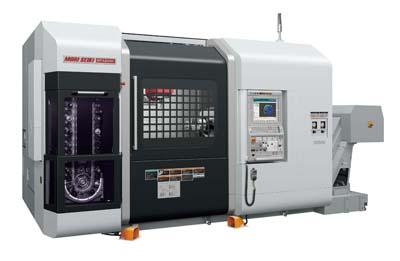
DMG/Mori Seiki's NTX2000 integrated mill turn center is a new model in the range of the X-class machines that have been designed to meet the needs of today's machine tool users. The NTX2000 is a compact integrated mill turn center with a maximum workpiece size of 660mm x 1,540mm. This machine is suitable for complex and high-precision machining, which is required to cut parts used in the aerospace, medical equipment and semiconductor industries.
The machine meets many different needs with extensive features including: Mori Seiki's original technologies, high productivity, space saving, high precision, MAPPS IV + ESPRIT and a wide choice of models. The NTX2000 uses Mori Seiki's original DDM (Direct Drive Motor), ORC (Octagonal Ram Construction) and BMT (Built-in Motor Turret) technologies, offering high-precision complete machining on small to medium sized parts.
Since the Spindle 2 of the NTX2000 has the same specifications as Spindle 1, machining processes can be flexibly assigned to each spindle. The high-speed drive of a tool spindle with a feedrate of 40 m/min maximizes the advantage of a distance between centers of 1,500mm. The ORC (Octagonal Ram Construction) supports the tool spindle movement in the Y-axis direction. Because the Y-axis structure located close to the cutting point consists of slideways, heavy-duty cutting can be performed with less vibration. The tool spindle is equipped with a built-in motor with output of 18.5/11 kW, which is equivalent to that of a No. 40 taper machining center. The NTX2000 machine with the tool spindle offers the highest level of milling. The NTX2000 machine uses a rounded cover design of the X-class machines, as well as a slanted keyboard that offers improved operability. Although the standard distance between centers is 1,500mm, the machine width has been shortened by 1,000mm and the installation area has been reduced by approximately 30 percent from our conventional machines.
To prevent thermal displacement in the spindle center, the Spindle 1 of the NTX2000 is designed to maintain its center in the same position, with a headstock whose front shape is symmetrical to the X- and Y-axis directions. Additionally, the slideways of the ORC, which are located diagonally opposite each other, distort symmetrically in response to heat, keeping the center of the moving parts in the same position. Thanks to these measures against thermal displacement, the NTX2000 machine can offer high-precision machining.
The NTX2000 also uses the three-point support. It is rare to use three-point support for a multi-axis machine, but this was made possible because of the robust NTX2000 bed. The NTX2000 machine offers long-term, high-precision machining with the three-point support structure, which is less affected by secular change. The MAPPS IV high-performance operating system has been installed on the operation panel. The combination of automatic programming software (standard) and ESPRIT CAM software (standard) allows the machine to handle complex machining programming and to flexibly meet customer needs.
In addition, the 3D interference checking function (standard) checks collisions between spindles, workpieces, soft jaws, tools, holders, and turrets in 3D. If interference is detected, it stops the machine in both automatic and manual modes. This offers the world's best protection against interference.
There are six NTX models available to meet various machining needs. By employing variation, each of them can flexibly handle machining that is usually performed on special machines.
Contact Details
Related Glossary Terms
- centers
centers
Cone-shaped pins that support a workpiece by one or two ends during machining. The centers fit into holes drilled in the workpiece ends. Centers that turn with the workpiece are called “live” centers; those that do not are called “dead” centers.
- computer-aided manufacturing ( CAM)
computer-aided manufacturing ( CAM)
Use of computers to control machining and manufacturing processes.
- gang cutting ( milling)
gang cutting ( milling)
Machining with several cutters mounted on a single arbor, generally for simultaneous cutting.
- machining center
machining center
CNC machine tool capable of drilling, reaming, tapping, milling and boring. Normally comes with an automatic toolchanger. See automatic toolchanger.
- milling
milling
Machining operation in which metal or other material is removed by applying power to a rotating cutter. In vertical milling, the cutting tool is mounted vertically on the spindle. In horizontal milling, the cutting tool is mounted horizontally, either directly on the spindle or on an arbor. Horizontal milling is further broken down into conventional milling, where the cutter rotates opposite the direction of feed, or “up” into the workpiece; and climb milling, where the cutter rotates in the direction of feed, or “down” into the workpiece. Milling operations include plane or surface milling, endmilling, facemilling, angle milling, form milling and profiling.
- milling machine ( mill)
milling machine ( mill)
Runs endmills and arbor-mounted milling cutters. Features include a head with a spindle that drives the cutters; a column, knee and table that provide motion in the three Cartesian axes; and a base that supports the components and houses the cutting-fluid pump and reservoir. The work is mounted on the table and fed into the rotating cutter or endmill to accomplish the milling steps; vertical milling machines also feed endmills into the work by means of a spindle-mounted quill. Models range from small manual machines to big bed-type and duplex mills. All take one of three basic forms: vertical, horizontal or convertible horizontal/vertical. Vertical machines may be knee-type (the table is mounted on a knee that can be elevated) or bed-type (the table is securely supported and only moves horizontally). In general, horizontal machines are bigger and more powerful, while vertical machines are lighter but more versatile and easier to set up and operate.

